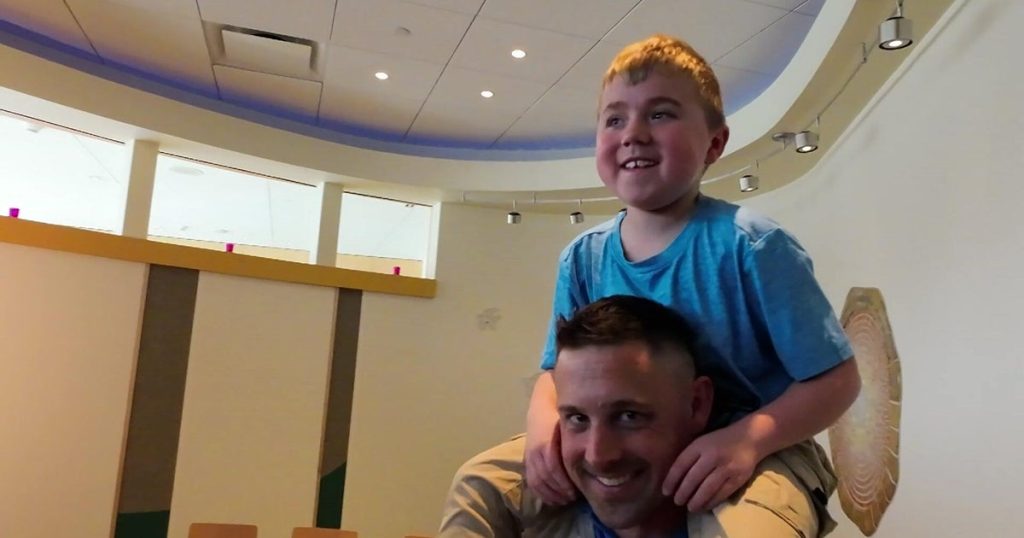An 8-year-old boy from northern Minnesota, Colton Belluzzo, has become one of the first individuals in the United States to receive an innovative gene therapy aimed at treating Duchenne muscular dystrophy (DMD). Diagnosed with this rare and debilitating condition at just seven months old, Colton’s situation has been remarkably transformed by groundbreaking medical advancements. His family, led by parents Dan and Morgan Belluzzo, expresses hope as they see signs of improvement in their son, who is now able to engage in activities he previously struggled with.
| Article Subheadings |
|---|
| 1) Understanding Duchenne Muscular Dystrophy |
| 2) Colton’s Journey to Gene Therapy |
| 3) The Gene Therapy Procedure Explained |
| 4) Early Results and Family Perspectives |
| 5) Future of DMD Treatments |
Understanding Duchenne Muscular Dystrophy
Duchenne muscular dystrophy (DMD) is a genetic disorder that primarily affects boys, manifesting in muscle weakness and degeneration over time. It is one of the most common types of muscular dystrophy, affecting approximately 1 in 5,000 live births worldwide. The condition arises from mutations in the gene responsible for producing dystrophin, a protein that plays a crucial role in muscle function. Without this protein, muscle fibers become damaged and gradually weaken, leading to severe physical disabilities. Most boys diagnosed with DMD do not survive past their late twenties or early thirties, which amplifies the urgency for effective treatments.
Colton’s Journey to Gene Therapy
When Colton was just seven months old, his parents Dan and Morgan Belluzzo received the heartbreaking diagnosis of DMD. Initially, they were unaware of the potential severity of the condition. As Colton grew, they witnessed the gradual loss of his muscle strength, which drastically affected his ability to perform everyday activities. By age 7, he faced significant difficulties, such as trouble standing up on his own. This troubling decline prompted the Belluzzo family to seek alternative treatments, leading them to Dr. Peter Karachunski at M Health Fairview Masonic Children’s Hospital. Dr. Karachunski was pioneering a new gene therapy procedure, and the family hoped that this innovative treatment would improve Colton’s quality of life.
The Gene Therapy Procedure Explained
The gene therapy that Colton underwent involves a sophisticated technique that uses a modified virus to deliver a healthy copy of the dystrophin gene directly into muscle cells. In December, following a series of preparatory evaluations and discussions, the medical team injected this engineered virus into Colton’s body. Dr. Karachunski explained that this process is designed to ‘put the brakes’ on the progression of DMD by restoring the levels of dystrophin in his muscles, which could slow muscle degeneration significantly. The virus used in this procedure is non-pathogenic, meaning it does not cause illness. By spreading throughout the muscle tissue, the treatment aims to enhance Colton’s muscle preservation and function.
Early Results and Family Perspectives
In the three months following the gene therapy, the changes in Colton’s condition have been astonishing. His parents have noticed marked improvements in his physical abilities. Activities that were once challenging, like going up and down stairs, have become easier for him to manage independently. Colton’s energy levels have increased, and he has shown greater willingness to engage in play and outdoor activities.
“Just his energy levels are higher. He can do things. He’s playing a lot more,”
commented Dan. The family is overwhelmed with gratitude for the advancements that have been made possible by medical research and the expertise of Dr. Karachunski.
Future of DMD Treatments
While the immediate effects of Colton’s gene therapy are encouraging, experts believe that further advancements in DMD treatments are on the horizon. Dr. Karachunski has indicated that multiple other therapies are currently undergoing clinical trials, aiming to provide novel methods of managing and treating muscular dystrophy. The Belluzzo family is hopeful that ongoing research and the future availability of additional treatments will continue to benefit Colton and others affected by this condition. These developments represent a significant leap towards transforming the prognosis for children diagnosed with DMD, offering powerful optimism where previously there seemed little hope.
| No. | Key Points |
|---|---|
| 1 | Colton Belluzzo is one of the first children in the U.S. to receive a gene therapy for Duchenne muscular dystrophy. |
| 2 | Duchenne muscular dystrophy primarily affects boys and leads to severe muscle degeneration. |
| 3 | The gene therapy technique uses a modified virus to deliver a healthy gene into muscle cells. |
| 4 | Colton’s early results post-treatment include increased energy and improved physical abilities. |
| 5 | Further advancements in DMD treatments are being explored in clinical trials, fostering hope for affected families. |
Summary
The story of Colton Belluzzo exemplifies the transformative potential of gene therapy for children suffering from Duchenne muscular dystrophy. As one of the first recipients of this innovative treatment in the United States, Colton’s journey reflects both the potential for significant medical advancements and the profound hope that such breakthroughs can bring to affected families. With ongoing research and emerging therapies on the horizon, there is renewed optimism for the future of DMD treatment, further inspiring the medical community and families alike.
Frequently Asked Questions
Question: What is Duchenne muscular dystrophy?
Duchenne muscular dystrophy is a genetic disorder that leads to progressive muscle degeneration and weakness, primarily affecting boys. It is caused by mutations in the dystrophin gene.
Question: How does gene therapy for DMD work?
Gene therapy for Duchenne muscular dystrophy works by delivering a copy of the dystrophin gene into muscle cells using a modified virus, which helps restore the production of the dystrophin protein necessary for muscle function.
Question: What are the potential benefits of the recent gene therapy received by Colton?
The potential benefits include slowing the progression of DMD, improving muscle strength and function, and enhancing the overall quality of life, as evidenced by Colton’s increased energy and independence in physical activities.


